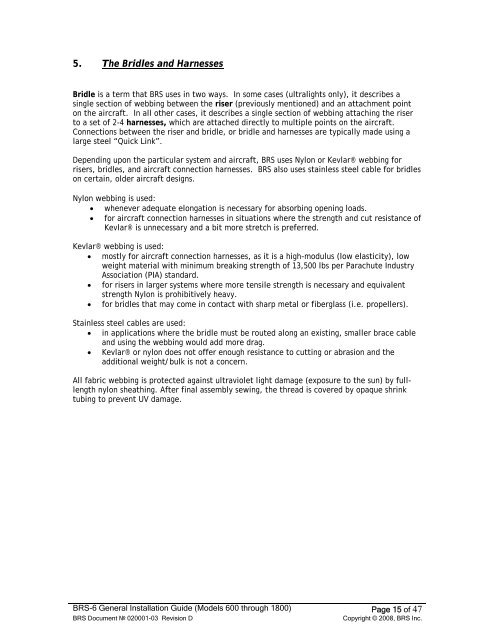BRS-6 General Installation Guide - CAFE Foundation
BRS-6 General Installation Guide - CAFE Foundation
BRS-6 General Installation Guide - CAFE Foundation
Create successful ePaper yourself
Turn your PDF publications into a flip-book with our unique Google optimized e-Paper software.
5. The Bridles and Harnesses<br />
Bridle is a term that <strong>BRS</strong> uses in two ways. In some cases (ultralights only), it describes a<br />
single section of webbing between the riser (previously mentioned) and an attachment point<br />
on the aircraft. In all other cases, it describes a single section of webbing attaching the riser<br />
to a set of 2-4 harnesses, which are attached directly to multiple points on the aircraft.<br />
Connections between the riser and bridle, or bridle and harnesses are typically made using a<br />
large steel “Quick Link”.<br />
Depending upon the particular system and aircraft, <strong>BRS</strong> uses Nylon or Kevlar® webbing for<br />
risers, bridles, and aircraft connection harnesses. <strong>BRS</strong> also uses stainless steel cable for bridles<br />
on certain, older aircraft designs.<br />
Nylon webbing is used:<br />
• whenever adequate elongation is necessary for absorbing opening loads.<br />
• for aircraft connection harnesses in situations where the strength and cut resistance of<br />
Kevlar® is unnecessary and a bit more stretch is preferred.<br />
Kevlar® webbing is used:<br />
• mostly for aircraft connection harnesses, as it is a high-modulus (low elasticity), low<br />
weight material with minimum breaking strength of 13,500 lbs per Parachute Industry<br />
Association (PIA) standard.<br />
• for risers in larger systems where more tensile strength is necessary and equivalent<br />
strength Nylon is prohibitively heavy.<br />
• for bridles that may come in contact with sharp metal or fiberglass (i.e. propellers).<br />
Stainless steel cables are used:<br />
• in applications where the bridle must be routed along an existing, smaller brace cable<br />
and using the webbing would add more drag.<br />
• Kevlar® or nylon does not offer enough resistance to cutting or abrasion and the<br />
additional weight/bulk is not a concern.<br />
All fabric webbing is protected against ultraviolet light damage (exposure to the sun) by fulllength<br />
nylon sheathing. After final assembly sewing, the thread is covered by opaque shrink<br />
tubing to prevent UV damage.<br />
<strong>BRS</strong>-6 <strong>General</strong> <strong>Installation</strong> <strong>Guide</strong> (Models 600 through 1800) Page 15 of 47<br />
<strong>BRS</strong> Document № 020001-03 Revision D Copyright © 2008, <strong>BRS</strong> Inc.

















